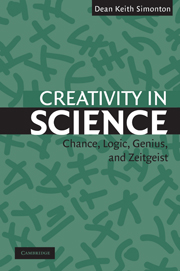Book contents
- Frontmatter
- Contents
- Preface
- Mathematical Notation
- Chapter 1 Introduction: Scientific Creativity
- Chapter 2 Creative Products
- Chapter 3 Combinatorial Processes
- Chapter 4 Scientific Activity
- Chapter 5 Creative Scientists
- Chapter 6 Scientific Discovery
- Chapter 7 Consolidation: Creativity in Science
- References
- Index
Chapter 7 - Consolidation: Creativity in Science
Published online by Cambridge University Press: 05 June 2012
- Frontmatter
- Contents
- Preface
- Mathematical Notation
- Chapter 1 Introduction: Scientific Creativity
- Chapter 2 Creative Products
- Chapter 3 Combinatorial Processes
- Chapter 4 Scientific Activity
- Chapter 5 Creative Scientists
- Chapter 6 Scientific Discovery
- Chapter 7 Consolidation: Creativity in Science
- References
- Index
Summary
Scientific creativity has now been examined from a multitude of viewpoints. Chapter 2 began the survey by looking at how creative products emerge from scientific careers and scientific communities. In particular, I described the distributions of publications across and within careers and the distinctive features of multiple discoveries. This chapter provided the critical behavioral data that inspired the theoretical interpretation provided in Chapter 3. The next three chapters then extended the explanatory thesis to other aspects of creativity in science. In Chapter 4, the focus was on scientific activity, which entailed the threefold scrutiny of the individual (research programs), the field (peer review), and the domain (disciplinary zeitgeist). Chapter 5 then turned to the dispositional characteristics and developmental factors associated with individual differences in scientific creativity. Finally, Chapter 6 presented the experimental literature on discovery processes, with special attention on the research regarding insight problems, creative production, computer problem solving, and group creativity.
The time has thus arrived to consolidate all these results and explanations. This consolidation begins by providing a synthesis of the four central perspectives on scientific creativity. It ends by discussing the larger implications of the theoretical and empirical findings.
Integration
As stressed in the opening chapter, scientific creativity may be viewed from four distinct perspectives: logic, genius, chance, and zeitgeist. In light of what has been shown in subsequent chapters, however, their order of treatment should be changed slightly here. Chance should be treated first, followed by logic, zeitgeist, and, lastly, genius.
- Type
- Chapter
- Information
- Creativity in ScienceChance, Logic, Genius, and Zeitgeist, pp. 160 - 184Publisher: Cambridge University PressPrint publication year: 2004



